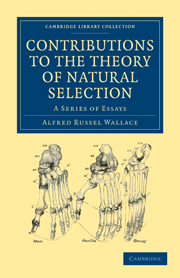Book contents
- Frontmatter
- Preface
- Preface to the Second Edition
- Contents
- I On the Law which has regulated the introduction of New Species
- II On the Tendency of Varieties to depart indefinitely from the Original Type
- III Mimicry, and other Protective Resemblances among Animals
- IV The Malayan Papilionidœ, or Swallow-tailed Butterflies, as illustrative of the Theory of Natural Selection
- V On Instinct in Man and Animals
- VI The Philosophy of Birds' Nests
- VII A Theory of Birds' Nests; showing the relation of certain differences of colour in female birds to their mode of nidification
- VIII Creation by Law
- IX The Development of Human Races under the Law of Natural Selection
- X The Limits of Natural Selection as applied to Man
- NOTES
- INDEX
VII - A Theory of Birds' Nests; showing the relation of certain differences of colour in female birds to their mode of nidification
Published online by Cambridge University Press: 29 August 2010
- Frontmatter
- Preface
- Preface to the Second Edition
- Contents
- I On the Law which has regulated the introduction of New Species
- II On the Tendency of Varieties to depart indefinitely from the Original Type
- III Mimicry, and other Protective Resemblances among Animals
- IV The Malayan Papilionidœ, or Swallow-tailed Butterflies, as illustrative of the Theory of Natural Selection
- V On Instinct in Man and Animals
- VI The Philosophy of Birds' Nests
- VII A Theory of Birds' Nests; showing the relation of certain differences of colour in female birds to their mode of nidification
- VIII Creation by Law
- IX The Development of Human Races under the Law of Natural Selection
- X The Limits of Natural Selection as applied to Man
- NOTES
- INDEX
Summary
The habit of forming a more or less elaborate structure for the reception of their eggs and young, must undoubtedly be looked upon as one of the most remarkable and interesting characteristics of the class of birds. In other classes of vertebrate animals, such structures are few and exceptional, and never attain to the same degree of completeness and beauty. Birds' nests have, accordingly, attracted much attention, and have furnished one of the stock arguments to prove the existence of a blind but unerring instinct in the lower animals. The very general belief that every bird is enabled to build its nest, not by the ordinary faculties of observation, memory, and imitation, but by means of some innate and mysterious impulse, has had the bad effect of withdrawing attention from the very evident relation that exists between the structure, habits, and intelligence of birds, and the kind of nests they construct.
In the preceding essay I have detailed several of these relations, and they teach us, that a consideration of the structure, the food, and other specialities of a bird's existence, will give a clue, and sometimes a very complete one, to the reason why it builds its nest of certain materials, in a definite situation, and in a more or less elaborate manner.
I now propose to consider the question from a more general point of view, and to discuss its application to some important problems in the natural history of birds.
- Type
- Chapter
- Information
- Contributions to the Theory of Natural SelectionA Series of Essays, pp. 231 - 263Publisher: Cambridge University PressPrint publication year: 2009First published in: 1870



